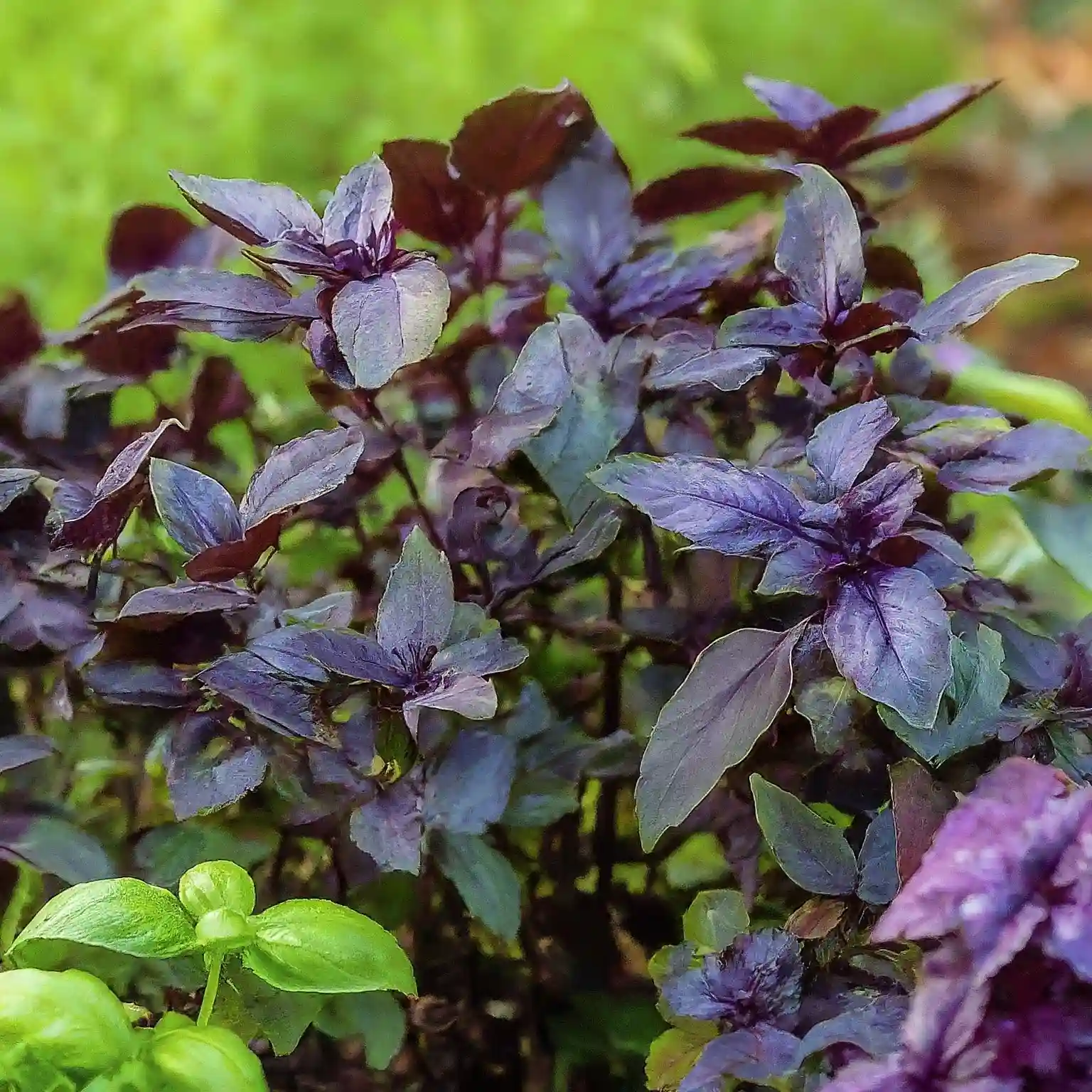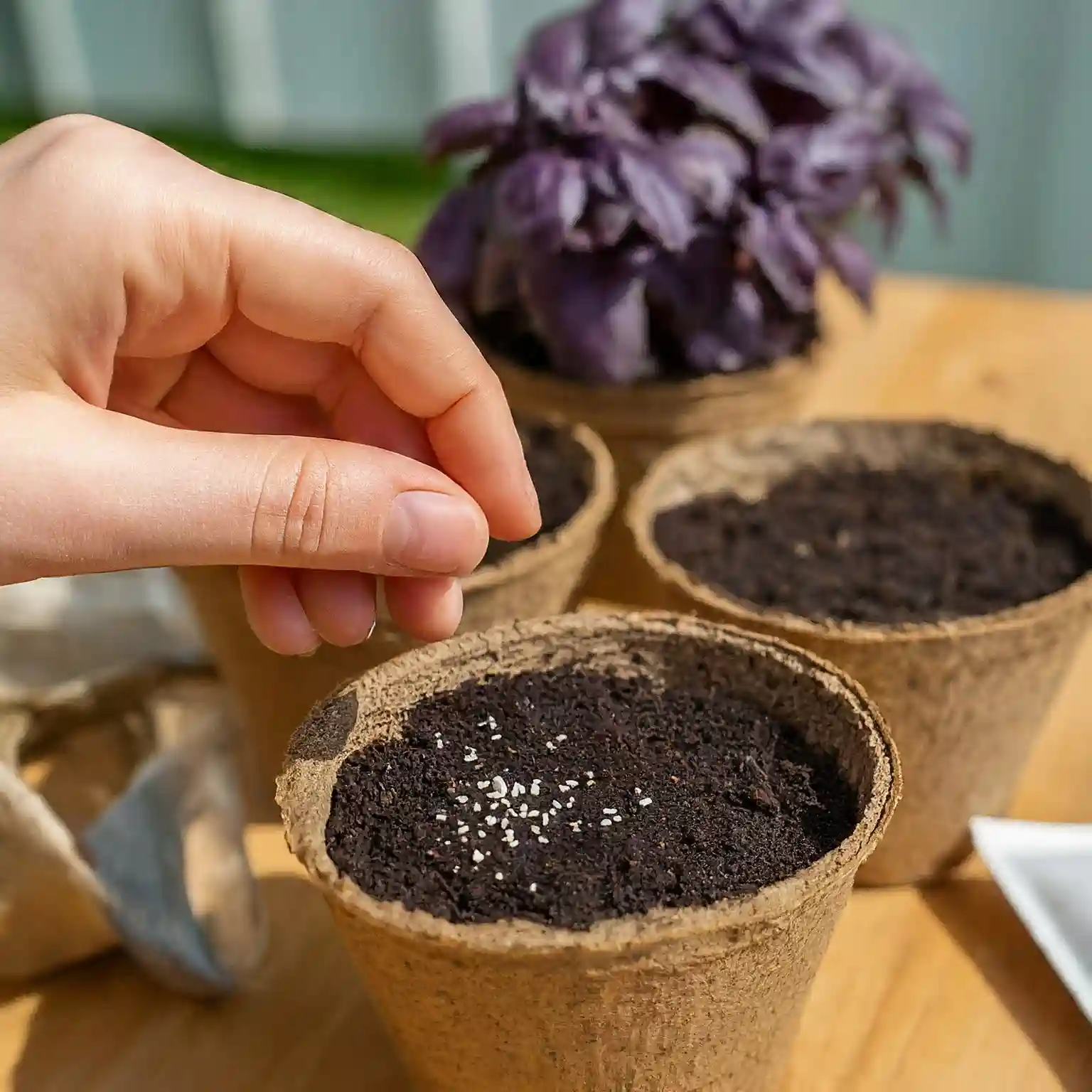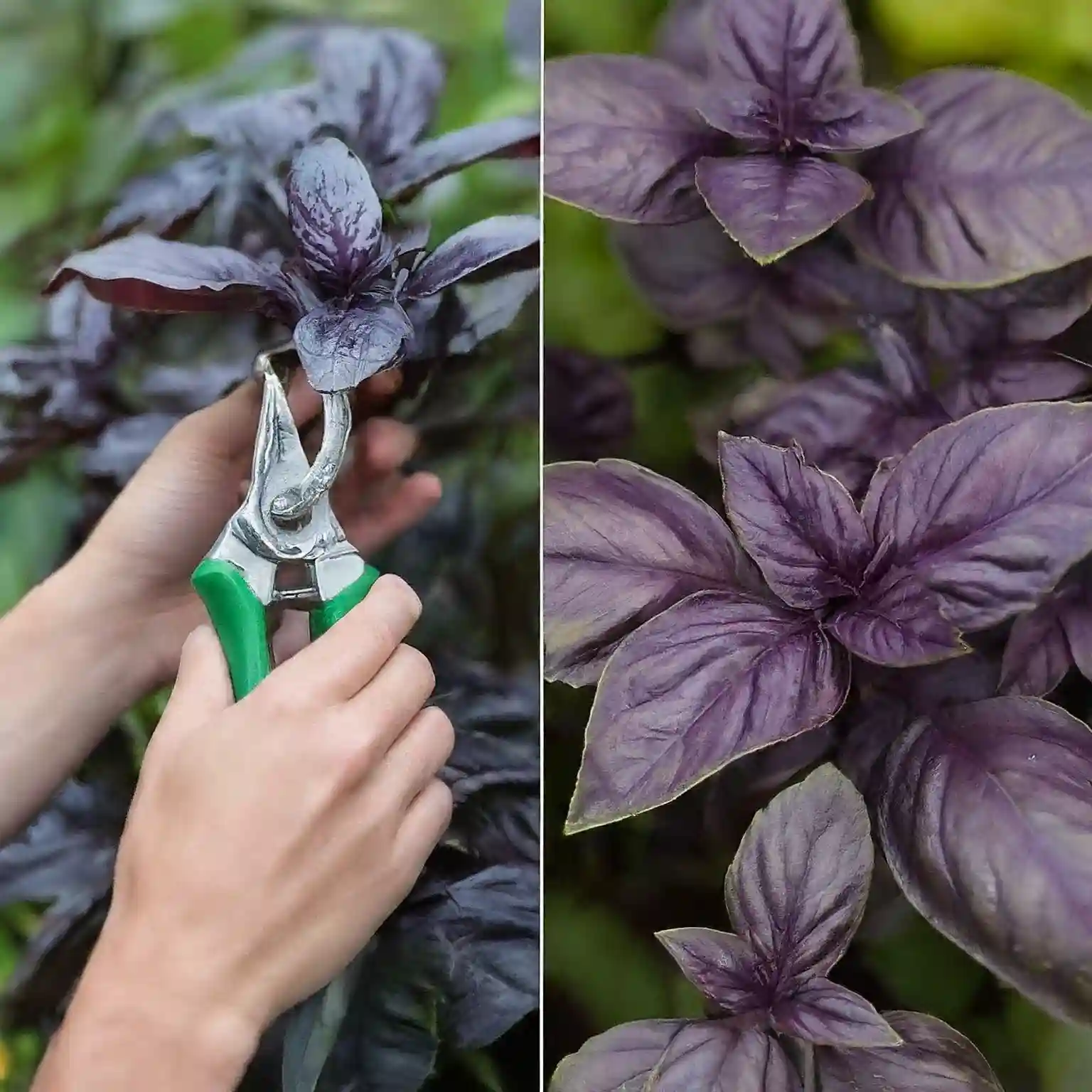How to Grow Dark Opal Basil: Unveiling the Secrets of the Purple Culinary Gem
Have you ever craved a culinary experience that’s both visually stunning and bursting with flavor? Look no further than the Dark Opal Basil, a unique variety prized for its breathtaking, deep purple leaves and intense, aromatic flavor. But how do you cultivate this mesmerizing herb and unlock its potential in your kitchen?

Growing your own Dark Opal Basil is not only rewarding but also surprisingly easy. This guide will walk you through every step of the process, from planting and germination to harvesting and storage. Whether you’re a seasoned gardener or a curious beginner, this comprehensive guide will equip you with the knowledge and confidence to cultivate your thriving patch of Dark Opal Basil. So, get ready to unleash the purple powerhouse and elevate your culinary creations to a whole new level!
Planting and Germination: Setting the Stage for Your Dark Opal Basil’s Success
The journey of how to grow dark opal basil starts with the foundation – planting and germination. This crucial stage sets the tone for the health and vibrancy of your future harvest. Let’s delve into the key aspects of creating the perfect environment for your Dark Opal Basil seeds to sprout and thrive:

Finding the Perfect Timing:
- Sowing seeds indoors: For optimal results, sow Dark Opal Basil seeds indoors 6-8 weeks before the last expected frost in your region. This ensures seedlings have ample time to establish themselves before being transplanted outdoors. You can check your last frost date using the USDA Plant Hardiness Zone Map.
- Planting outdoors: Once the danger of frost has passed and soil temperatures reach consistently around 65°F (18°C), you can directly sow your Dark Opal Basil seeds outdoors.
Creating a Thriving Home:
Choosing the right soil is paramount for how to grow dark opal basil successfully. Dark Opal Basil thrives in well-draining, fertile soil. Here are some options:
- Potting mix: Opt for a high-quality, organic potting mix specifically formulated for herbs. These mixes usually contain a good balance of drainage and moisture retention.
- Raised beds: If planting outdoors, consider creating raised beds. This allows for better control over soil quality and drainage, which is crucial for basil plants. Amending your existing garden soil with compost or aged manure can also significantly improve drainage and fertility.
Planting Like a Pro:
Once you have your chosen soil, follow these simple steps for planting your Dark Opal Basil seeds:
- Sow seeds at a depth of ½ inch (1 cm) and space them 6-8 inches (15-20 cm) apart.
- Gently water the soil to moisten it thoroughly, but avoid overwatering.
- Place the pot or seed tray in a warm location (around 70°F or 21°C) with bright, indirect sunlight. You can also use a seed starting mat to maintain a consistent soil temperature for optimal germination.
Witnessing the Magic of Germination:
With proper care, your Dark Opal Basil seeds should germinate within 5-10 days. During this stage, it’s crucial to maintain consistent moisture in the soil by watering regularly but avoiding waterlogging. Once the first true leaves appear (the second set of leaves after the cotyledons), your seedlings are ready for the next step in their journey!
By following these guidelines, you’ll be well on your way to establishing a strong foundation for your Dark Opal Basil. Remember, patience and consistent care are key during this initial stage of how to grow dark opal basil.
Care and Maintenance: Nurturing Your Dark Opal Basil to Thrive
Growing Dark Opal Basil requires providing the necessary care and maintenance to ensure its healthy growth and bountiful harvest. Here are the key aspects to consider:

Sunlight:
- Full sun is essential for optimal growth of your Dark Opal Basil. Aim for at least 6-8 hours of direct sunlight daily.
- If growing indoors, position your basil plant near a south-facing window that receives ample sunlight. While partial shade may be tolerated in some situations, the plant will likely become leggy and produce fewer leaves.
Watering:
- Water your Dark Opal Basil regularly but avoid overwatering. The soil should be moist to the touch, but not soggy.
- During hot and dry weather, you may need to water your basil more frequently. Conversely, reduce watering in cooler weather or when the soil feels damp.
- A helpful tip is to check the soil moisture level by sticking your finger into the soil about an inch deep. If it feels dry, it’s time to water.
- Always water at the base of the plant and avoid getting water on the leaves, as this can promote fungal diseases.
Fertilizing:
- While not strictly necessary, occasional fertilization can benefit your Dark Opal Basil, especially if grown in containers.
- Opt for a balanced organic fertilizer or a diluted liquid fertilizer formulated for herbs. Follow the instructions on the fertilizer package for application rates and frequency.
Pinching and Pruning:
- Pinching and pruning are essential techniques in growing Dark Opal Basil and other basil varieties. This encourages bushier growth, prevents flowering (which can diminish leaf production), and promotes the production of more flavorful leaves.
- Pinch off the top leaves when the plant reaches about 6-8 inches tall. This will encourage the plant to branch out and produce more leaves.
- You can continue to pinch off new growth throughout the growing season to maintain a bushy and productive plant.
By following these simple care and maintenance practices, you can nurture your Dark Opal Basil and enjoy its vibrant presence and unique flavor for the entire season. Remember, for a more detailed guide on specific aspects of basil care, you can explore our resources on watering basil indoors, identifying basil plant problems, and keeping basil plants compact.
Harvesting and Storage: Bringing Home the Rewards of Your Dark Opal Basil
The culmination of your how to grow dark opal basil journey arrives with harvest! Here’s how to reap the rewards of your cultivation efforts and enjoy the unique flavor of your Dark Opal Basil for weeks to come.

Ready to Reap the Rewards:
- Harvesting your Dark Opal Basil can begin once the plant reaches 6-8 inches tall and has developed several sets of true leaves (the leaves that appear after the initial cotyledons).
- You can refer to our guide on the ultimate guide to harvesting basil for a more detailed explanation of basil harvesting.
- To harvest, use sharp shears or scissors to cut stems just above a node (the bump where leaves meet the stem). Avoid cutting too close to the base of the plant, as this can stunt growth.
- Regular harvesting throughout the growing season promotes bushier growth and encourages your Dark Opal Basil to produce more leaves.
Preserving the Freshness:
While fresh basil is undoubtedly the most flavorful option, it’s important to remember that it has a short shelf life. Here are some tips for storing your harvested Dark Opal Basil:
- Refrigeration: Place freshly cut basil sprigs in a glass of water, cover them loosely with a plastic bag, and store them in the refrigerator for up to 5 days.
- Freezing: For longer storage, you can freeze basil leaves in an airtight container. Simply wash and dry the leaves thoroughly before freezing, and they will last for up to 6 months.
- Drying: Drying is another option for long-term storage. Dehydrate your basil leaves in a dehydrator or a well-ventilated, warm location. Once dried, store the leaves in an airtight container in a cool, dark place for up to a year.
By harvesting and storing your Dark Opal Basil effectively, you can extend its enjoyment and savor its unique flavor for weeks to come. Explore our additional resources on keeping basil fresh for the winter and basil plant care in winter for even more tips on preserving your harvest.
Troubleshooting Common Problems: Overcoming Challenges in Your Dark Opal Basil Journey
Even the most devoted gardeners encounter occasional challenges with their plants. Growing Dark Opal Basil is no exception. Here are some common issues you might face and solutions to help your basil thrive:
Pests and Diseases:
- Aphids, slugs, and whiteflies are common pests that can target basil plants. Regularly inspect your basil for signs of infestation, and consider using organic methods like insecticidal soap or neem oil to control them. You can find more information on getting rid of aphids on basil plants.
- Fungal diseases like downy mildew can also affect basil. Ensure proper air circulation around your plants and avoid overwatering. If you notice signs of disease, remove affected leaves and consider using a fungicide labeled safe for use on herbs. Refer to our resources on identifying basil plant problems for further guidance.
Leggy Growth:
- If your Dark Opal Basil appears tall and leggy with minimal leaves, it’s likely not receiving enough sunlight. Ensure your plant is getting at least 6-8 hours of direct sunlight daily.
- Pinching and pruning regularly will also encourage bushier growth and prevent legginess. Refer to our guide on pruning basil plants for more leaves.
Yellowing Leaves:
- Yellowing leaves can be caused by various factors, including overwatering, underwatering, lack of nutrients, or even pests.
- Check the soil moisture level and adjust watering accordingly. If the soil feels constantly wet, consider improving drainage.
- If underwatering is suspected, increase watering frequency.
- You can also consider providing occasional fertilization, especially if your basil is growing in a container.
By understanding these common problems and their solutions, you can effectively address challenges and ensure your Dark Opal Basil flourishes throughout the growing season.
Remember, for more comprehensive guidance on specific basil care concerns, explore our resources on identifying basil plant problems and keeping basil plants alive.
Conclusion: The Rewards and Versatility of Dark Opal Basil
Growing Dark Opal Basil is a rewarding experience, offering not only the satisfaction of cultivating your herb but also the unique flavor it brings to your culinary creations.
Beyond the Basics:
This guide has equipped you with the essential knowledge to grow Dark Opal Basil successfully. However, the journey doesn’t end here! As you gain experience, you can explore further:
- Experiment with different growing methods: Try growing your Dark Opal Basil indoors during colder months or consider propagating new plants from cuttings.
- Discover the culinary versatility of Dark Opal Basil: Explore its unique flavor profile in various dishes, from pesto and salads to pasta sauces and tomato dishes. You can even use it to create infused oils and vinegar.
- Learn about companion planting: Discover plants that complement your Dark Opal Basil and potentially deter pests while attracting beneficial insects.
By embracing the process of learning and exploration, you can cultivate not only a thriving Dark Opal Basil plant but also a deeper appreciation for the world of home gardening and the culinary delights it offers.
Frequently Asked Questions about Growing Dark Opal Basil:
Q: How much sunlight does Dark Opal Basil need?
A: Dark Opal Basil thrives in full sun, receiving at least 6-8 hours of direct sunlight daily. If growing indoors, position your plant near a south-facing window for optimal light exposure.
Q: How often should I water my Dark Opal Basil?
A: Water your Dark Opal Basil regularly, but avoid overwatering. The soil should be moist to the touch, but not soggy. Water deeply when the top inch of soil feels dry, and adjust watering frequency based on weather conditions.
Q: Do I need to fertilize my Dark Opal Basil?
A: While not strictly necessary, occasional fertilization can benefit your Dark Opal Basil, especially if grown in containers. Opt for a balanced organic fertilizer or a diluted liquid fertilizer formulated for herbs, following the instructions on the package for application rates and frequency.
Q: How do I harvest Dark Opal Basil leaves?
A: You can begin harvesting your Dark Opal Basil once the plant reaches 6-8 inches tall and has developed several sets of true leaves. Use sharp shears or scissors to cut stems just above a node (the bump where leaves meet the stem). Avoid cutting too close to the base of the plant to encourage bushier growth.
Q: Can I grow Dark Opal Basil indoors?
A: Yes, you can grow Dark Opal Basil indoors! Choose a sunny location near a south-facing window and provide at least 6-8 hours of direct sunlight daily. Ensure proper drainage and follow consistent watering practices to prevent overwatering. Explore our guide on caring for basil plants indoors for more details.
Q: What are some common problems with Dark Opal Basil, and how can I fix them?
A: Common problems include pests like aphids, fungal diseases like downy mildew, and leggy growth due to insufficient sunlight. Regularly inspect your plant, address pest issues with organic methods if possible, and ensure proper drainage and air circulation to prevent diseases. Prune regularly to encourage bushier growth and address legginess. Refer to our resources for troubleshooting specific problems:
Pests and Diseases
Leggy Growth
Q: What are some creative ways to use Dark Opal Basil?
A: Beyond the classic use in pesto and salads, Dark Opal Basil’s unique flavor profile complements various dishes. Try it in pasta sauces, tomato dishes, infused oils, and vinegar, or even as a garnish for soups and stews.